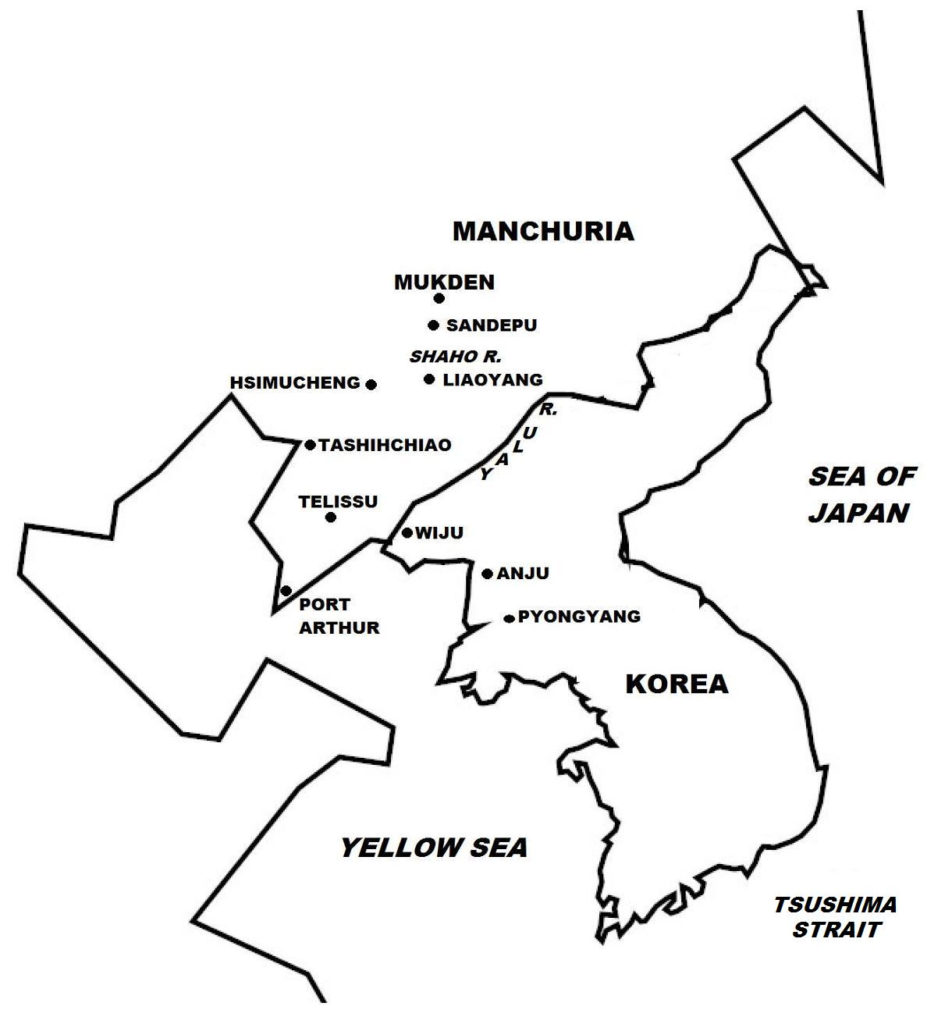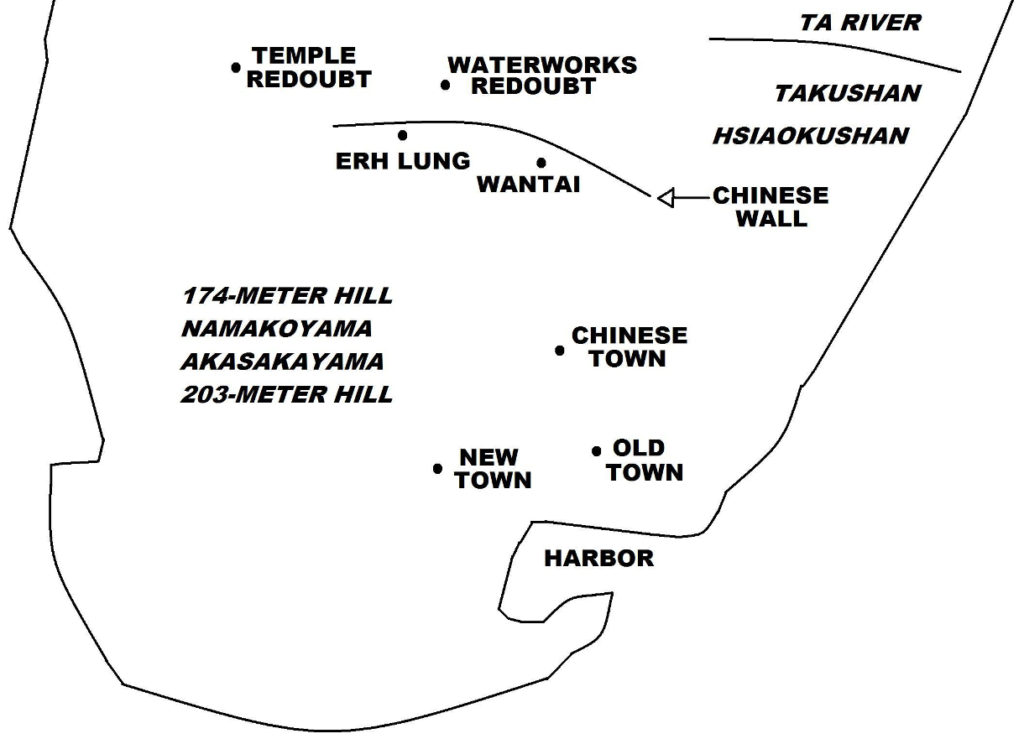The Japanese launched their offensive across the Yalu River using a diversionary attack on Antung as a feint. Japanese forces then crossed the Yalu River along three points further east, and then threatened the Russians with encirclement. Heavy fighting broke out on April 29, 1904, but with their left flank collapsing, the Russians were forced to abandon their positions and retreat north to Manchuria. With their victory at the Battle of Yalu River, the Japanese entered Manchuria. Most of the battles of the war subsequently would be fought in Manchuria.

The Japanese Army moved to take Port Arthur. In early May 1904, Japanese forces landed its nearly 40,000-strong Second Army on the southern coast of the Liaodong Peninsula and north of Port Arthur. The approaches to the Russian defenses were heavily fortified by an elaborate network of trenches and barb wire, and artillery pieces and machine guns. Fighting broke out on May 24-26, 1904, with the numerically superior Japanese forces (outnumbering the Russians by 10:1) making many unsuccessful frontal attacks on the Russian positions, and incurring heavy casualties. But Chinchou fell on May 25, and the strategic Nashan Hill (which the Japanese failed to take in nine attempts) was captured the following day. The Russians were forced to retreat after failing to secure badly needed reinforcements. The Japanese then occupied the nearby port of Dalny, which the Russians had earlier abandoned, leaving Dalny’s facilities, to the amazement of the Japanese, virtually intact, including warehouses, railway lines and train cars, and port machinery.
(Taken from Russo-Japanese War – Wars of the 20th Century – Twenty Wars in Asia – Volume 5)
.With Japanese forces now threatening Port Arthur, the Russian high command in Manchuria assembled a relief force of 33,000 troops to move south and breach the Japanese lines, and proceed to reinforce Port Arthur. Upon receiving word of this Russian advance, Japanese forces, numbering 40,000 troops, were ordered to proceed north. On June 14-15, 1904, fighting took place near the village of Telissu. There, the Russians had strengthened their right flank, but the Japanese attack broke through on the Russians’ weak left flank. A Russian counterattack, poorly coordinated, petered out. Threatened with encirclement, the Russians retreated north toward Mukden, which ended Russian hopes of reinforcing Port Arthur.
The war shifted further toward the western coast of the Liaodong Peninsula, at the town of Tashishchiao, a strategic railway junction, which the Japanese command saw as important to further isolating Port Arthur and allowing its forces to move north into Manchuria. The advance toward Kaiping and Tashihchiao saw teams of Japanese soldiers manually hauling train cars (loaded with their equipment and supplies) on the railroad tracks, as Japanese sea transports carrying the locomotives had been lost to Russian naval attacks. In the ensuing battle at Tashihchiao, fought on July 24-25, 1904, by opposing 64,000 Japanese and 60,000 Russian troops, Japanese frontal attacks on Russian entrenched positions were thrown back. Russian artillery fire inflicted heavy casualties on the Japanese. But a surprise nighttime flanking maneuver by Japanese forces broke through on the weak Russian left side, forcing the Russians to abandon Tashihchiao and retreat north toward Liaoyang.
Meanwhile in the south, the Japanese Third Army, with 90,000 troops and hundreds of artillery pieces, was preparing to attack Port Arthur. Japanese military planners anticipated an easy conquest of Port Arthur, as ten years earlier in a war with China (the First Sino-Japanese War in 1894-1895), Port Arthur (then known as Lushunkou) had fallen to a Japanese attack within a single day. However, the Russians had greatly fortified Port Arthur, constructing new defenses and enhancing or expanding existing ones. By the time the war began, Port Arthur was one of the most heavily fortified places in the world. Some 50,000 Russian troops and 500 artillery pieces protected the Russian Pacific Fleet at the port. Also crucial to Port Arthur’s defense were the heavily fortified hills on the north and west overlooking the city.

On August 7, 1904, the Japanese Army launched the attack to take Port Arthur from the northeast. By August 9, Japanese forces had taken the two eastern hills after sustaining heavily casualties from many failed attempts. However, the assaults on the western hills, which began on August 19, 1904, proved disastrous, and with casualties topping 16,000 men with little territory gained by August 24, the Japanese command called off the attack. The Japanese then settled down to a siege of Port Arthur, which ultimately lasted over four months. The Japanese built trenches and tunnels to allow their troops to slowly advance toward the Russian fortifications. Then, the ramparts of the fortifications were brought down with powerful explosives. In this way, the Japanese captured the Waterworks Redoubt and Temple Redoubt. However, in September-October 1904, Japanese attempts using massed frontal assaults to storm the western hills were repulsed, with the Japanese suffering heavy casualties.
Battle of Port Arthur.Meanwhile, in the northern sector of the war, following their victory at Tashihchiao, the Japanese Army continued to advance north into Manchuria. In late July 1904, the Japanese 4th Army and units of the 2nd Army, numbering some 34,000 troops, clashed with the Russian 2nd Siberian Corps, which totaled 33,000 troops, at Hsimucheng. Again, the Japanese used a flanking attack to break through a weak section in the Russian lines. Threatened with encirclement, the Russians retreated north to Haiching. The stage then was set for the first of a series of major battles for control of southern Manchuria.
The Japanese Army now eyed Liaoyang, a major population center along the Mukden-Port Arthur railway line, and assembled three field armies comprising 130,000 troops and 500 artillery pieces to advance to the city. General Kuropatkin, the commander of all Russian forces in Manchuria, had organized three lines of defense at Liaoyang, which were manned by several Russian Army Corps, the total Russian strength numbering 160,000 soldiers and 670 artillery pieces. The battle for the city, which took place on August 25-September 5, 1904, saw repeated Japanese attacks being thrown back by strong Russian artillery fire. However, General Kuropatkin, wrongly believing that the Japanese forces greatly outnumbered his own, repeatedly ordered his units to abandon their positions and retreat to the inner defensive lines, which dismayed his subordinate generals who pressed for a counterattack. With Japanese units soon breaking through and threatening to encircle the city, General Kuropatkin evacuated his forces from Liaoyang, and retreated north.
